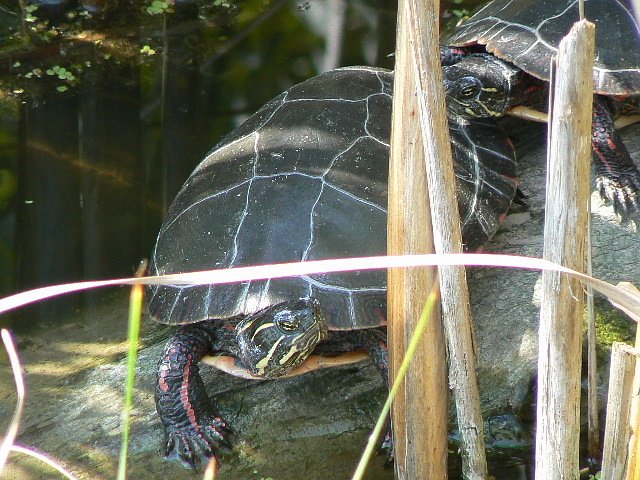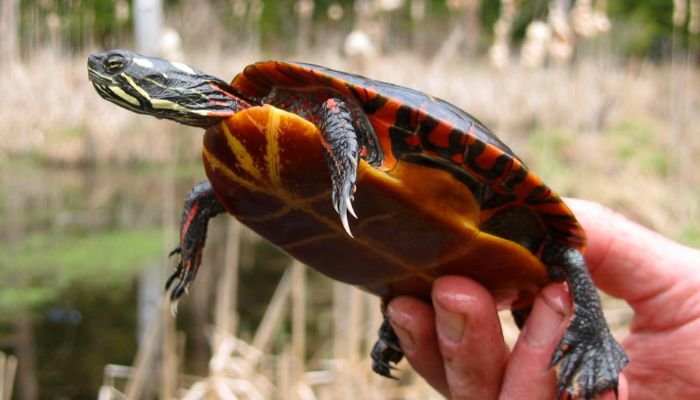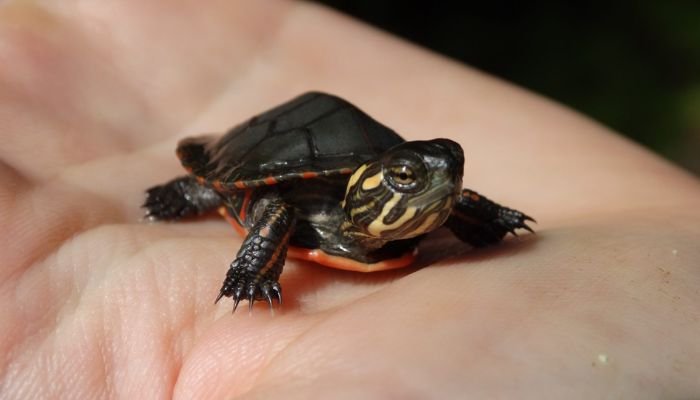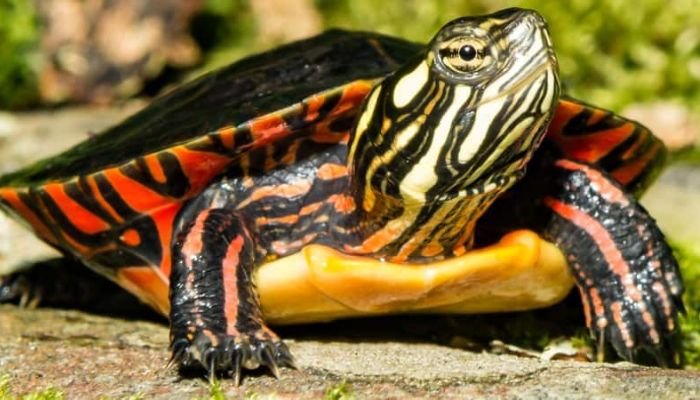
Painted turtle inhabits North American freshwater ecosystems. Due to its colorful markings and startling red and yellow plastron, the Painted Turtle is a popular reptile among those who appreciate nature. It is primarily aquatic and feeds on a diversity of aquatic plants, insects, and small invertebrates. By regulating the growth of aquatic plants and serving as prey for other predators, painted turtles substantially contribute to the health of their respective ecosystems.. Here are Painted turtle Guide on Food, Habitat, Size, Lifespan & Predators below-
Painted turtle Stats in Table format
The stats are given below for Painted turtle
| Reptiles List | Painted turtle |
|---|---|
| Family | Emydidae |
| Type | Turtle |
| Size | Small to Medium |
| Length | Painted turtle: Up to 4-7 inches (10-18 cm) |
| Color | Painted turtle: The color varies depending on the subspecies, but painted turtles can have shades of green, brown, or black with red or yellow markings. |
| Weight | Painted turtle: The weight varies depending on the species, but most painted turtles weigh between a few ounces to a pound or more.. |
| Lifespan | 20-30 years (or more) |
| Reproduction | |
| Gestation Periods | 55-75 days |
| Endangered Status | The Painted Turtle (Chrysemys picta) is not considered an endangered species. |
| Features | The Painted Turtle (Chrysemys picta) is not considered an endangered species. |
| Country & Areas | North America, Canada, United States, Mexico, Central America, Eastern United States, Great Lakes region, Atlantic coast, Pacific coast |
Painted Turtle Natural Habitat and Distribution
Most of the time, you can spot a Painted Turtle in a body of fresh water, such as a pond, lake, river, marsh, or even a slow-moving stream. They have been found in brackish water and may survive in a wide variety of habitats, from temporary ponds to big lakes.
The United States and Canada account for the vast majority of this turtle’s range in North America. From Nova Scotia to the panhandle of Florida, the Eastern Painted Turtle can be found all along the Atlantic and Gulf coasts. The range of the Midland Painted Turtle extends from the Great Lakes area through the middle of the United States. Two species of painted turtles are present in North America; one lives in the western United States and Mexico, and the other lives in the southern United States and northern Mexico.
Painted Turtle Physical Features and Adaptations
Here are some information about Painted Turtle Physical Features and Adaptations
1. Body Structure
The carapace (top shell) of the painted turtle is streamlined, flattened, and oval-shaped, and it protects the turtle’s internal organs. Paintwork in yellow, red, and black decorates the carapace, giving rise to the common name “Painted Turtle.” Because of the hinge in their plastron (bottom shell), they can hide their head and arms when threatened.
2. Coloration and Patterns
The shell of the Painted Turtle is decorated with bright colors and patterns that evoke brushstrokes in yellow, red, and black. Not only do they have colorful shells, but their flesh and brains are as well.

3. Defense Mechanisms
Painted turtles have developed several defense mechanisms that allow them to survive in their natural habitat. When threatened, it draws its head and limbs under its shell, making it difficult for predators to access its vulnerable abdomen. In addition, they can release a foul odor to deter potential assailants.
Painted Turtle Diet and Feeding Habits
Here are some information about Painted Turtle Diet and Feeding Habits
1. Diet Type
Because of their omnivorous diet, painted turtles can be found eating both plants and animals. They are able to thrive in their environment by eating a wide variety of foods thanks to their adaptable diet.
2. Preferred Food Sources
Aquatic plants, algae, insects, tiny fish, tadpoles, and crustaceans make up the bulk of a Painted Turtle’s diet in the wild. They are opportunistic eaters that will consume whatever is accessible.
3. Feeding Schedule
Diurnal means that Painted Turtles are most active during daylight hours. They hunt for food throughout the day and relax or sun themselves in the evening.
Painted Turtle Housing and Enclosure Requirements
Here are some information about Painted Turtle Housing and Enclosure Requirements
1. Terrarium Size and Setup
Captive Painted Turtles need a sizable aquarium to thrive in. To allow sufficient swimming room, the terrarium should be at least 4 feet in length and 2 feet in width. The turtles need a place to dry off and soak up some UVB rays, so make sure there’s a basking spot available.
2. Substrate Options
The terrarium’s bottom should be lined with a substrate that is representative of the turtle’s native environment. An aquarium can be enriched with fine gravel or sand, smooth rocks, and aquatic plants.
3. Temperature and Lighting
Painted turtles can’t maintain their body temperature without a basking place equipped with a heat light. While the water temperature should be kept between 75 and 85 degrees Fahrenheit (24 and 29 degrees Celsius), the basking place should be kept at a comfortable 90 to 95 degrees Fahrenheit (32 to 35 degrees Celsius). Calcium metabolism and general health both require UVB lighting.

4. Humidity and Water Needs
Because of their aquatic nature, painted turtles require a large amount of dechlorinated water in their enclosure. Swimming depth and a shallow area for sunbathing convenience are both desirable. Maintaining a humidity level in the enclosure between 60 and 70 percent is important for their health.
Painted Turtle Behaviour and Temperament
Here are some information about Painted Turtle Behaviour and Temperament
1. Activity Levels
Most of a painted turtle’s day is spent swimming, sunning, and searching for food. They can swim quickly and can often be spotted warming themselves in the sun on logs or rocks.
2. Social Behaviour
However, during mating season or when food is plentiful, painted turtles may tolerate other individuals of their own species in their habitat.
3. Handling and Taming
Despite the fact that Painted Turtles can be trained to recognize their owners, they are not commonly kept as a “hands-on” pet. The turtles should be handled as little as possible and with as much care as possible to prevent stress. To prevent spreading bacteria, wash hands thoroughly before and after handling.
Painted Turtle Breeding and Reproduction
Here are some information about Painted Turtle Breeding and Reproduction
1. Mating and Courtship Rituals
Internal fertilization is used in the reproduction of painted turtles. Males do things like bobbing their heads and swimming in front of females to try to catch their attention during mating season. After a successful courting, mating takes place in the water.
2. Incubation and Hatchlings
After mating, the female creates a little nest in soft soil, where she deposits her eggs. Hatchlings emerge from the eggs after a natural incubation period of 60-80 days. The temperature determines whether the hatchlings are female or male; higher temperatures result in females and lower temperatures result in males.
Painted Turtle Common Health Issues and Veterinary Care
Here are some information about Painted Turtle Common Health Issues and Veterinary Care:-
1. Respiratory Infections
When kept in captivity, Painted Turtles are especially vulnerable to respiratory diseases because to poor environmental conditions. Inadequate temperature and humidity can also contribute to the spread of these illnesses.
2. Parasites:
Painted turtles are susceptible to parasites both internal and external. Parasite avoidance and regular fecal tests are crucial for their wellbeing.
3. Metabolic Bone Disease
Metabolic bone disease, brought on by insufficient calcium intake or inadequate UVB exposure, can weaken and distort a turtle’s skeleton.
Importance of Regular Vet Check-ups
Captive Painted Turtles require routine veterinary care. The health of your reptile, as well as any warning indications of illness, can be evaluated by a trained veterinarian. Captive Painted Turtles benefit greatly from routine health examinations, which can extend their lives and improve their quality of life.

Conclusion:
The stunning colour, versatile temperament, and one-of-a-kind adaptations of the Painted Turtle make it an interesting reptile to study. These turtles can be found all over North America in their natural watery habitat. They need a stable aquatic enclosure with the right temperature, lighting, and substrate when kept in captivity. They are fascinating pets for people who are interested in reptiles because of their omnivorous food and diurnal activity.
Whether you’re taking care of a Painted Turtle in the wild or keeping one as a pet, you’ll need a thorough awareness of its habits and needs. The survival and preservation of this extraordinary reptile species can be ensured by creating an environment that is as near as possible to its native habitat and catering to its dietary and health requirements.
FAQs
Q: What is the family and Type of a Painted turtle?
A: The Painted turtle is a species of family Emydidae. The Famous Painted turtle is a member of the family Turtle.
Q: What is the average size of a Painted turtle?
A: The average adult Painted turtle is Small to Medium between Painted turtle: Up to 4-7 inches (10-18 cm).
Q: How long can a Painted turtle grow in size in lengths?
A: Painted turtle is Small to Medium in size and The painted turtle is a species of turtle that typically grows to be about 4-7 inches (10-18 cm) in size.
Q: What colors do Painted turtle come in?
The variety of hues found in the painted turtle makes it an interesting species. Depending on the subspecies, these turtles might be green, brown, or black with striking red or yellow markings.
Q: How big can a Painted turtle get in weight?
A: The weight of painted turtles can vary depending on the species, with most of them weighing between a few ounces to a pound or even more.
Q: What are the special Features of a Painted turtle?
A: Painted turtle are The Painted Turtle (Chrysemys picta) is not considered an endangered species.
Q: How long do Painted turtle live?
A: The usual lifespan of an Painted turtle is The painted turtle has a lifespan of around 20-30 years, although some individuals may live even longer.
Q: What food does the Painted turtle eat?
The diet of a painted turtle consists primarily of algae, insects, crustaceans, and other small aquatic animals. They consume anything, including dead animals and carrion, because they are omnivores. Because of their slow metabolism, they can go for extended periods of time without eating. It is common knowledge that they go into hibernation during the colder months when food is scarce.
Q: What is the best habitat for a Painted turtle?
A: A painted turtle does best in a freshwater setting that features both land and water. They do well in still bodies of water with abundant vegetation and submerged logs for basking, such as ponds, lakes, and slow-moving rivers. Clean, oxygenated water between 70 and 80 degrees Fahrenheit (21.1 and 26.7 degrees Celsius) is ideal. For nesting and burrowing, the land region should be sandy or muddy. Natural sunlight is the best source of vitamin D, hence it’s crucial to offer a UVB light source to simulate its effects. In order to feel safe in the habitat, there should be places to hide, such as behind rocks or behind vegetation. The turtle’s well-being depends on regular care, such as water filtration and temperature regulation.
Q: How do Painted turtle give birth?
A: Painted turtle are
Q: How long is the gestation period for an Painted turtle?
A: The gestation period of an Painted turtle is approximately 55-75 days
Q: What is the natural behavior of an Painted turtle?
Most painted turtles are found in Because it is a semi-aquatic species, a painted turtle’s natural behavior includes spending a lot of time in the water. They can swim well and can often be spotted warming themselves in the sun on logs or rocks. The diet of a painted turtle includes a wide variety of plant life, insects, crabs, and tiny fish. Although they usually live alone, during breeding season they often congregate. Attractive males will perform courtship rituals during this period. Another interesting fact about painted turtles is that they hibernate throughout the winter by burrowing into the mud or sand at the bottom of ponds and lakes.
Q: Is the Painted turtle endangered?
A: The Painted turtle is The Painted Turtle (Chrysemys picta) is not considered an endangered species..
Q: What are the prey of Painted turtle?
A: The prey of the painted turtle includes small fish, tadpoles, insects, crustaceans, and aquatic plants..
Q: Do Painted turtle have any Predators?
To answer your question, yes, painted turtles do Raccoons, skunks, foxes, birds of prey, and predatory fish like bass and pike are just few of the animals that prey on painted turtles. The eggs and hatchlings of painted turtles are the primary prey of these predators, but adult turtles are not immune to attack. In some areas, painted turtles may also be threatened by snapping turtles and other large water predators.
Q: How Fast Does Painted turtle Move?
A: The painted turtle can move at a speed of up to 3-4 miles per hour on land and around 1-2 miles per hour in water.
Q. What is Bite Force of Painted turtle in PSI?
A. Bite Force in PSI is a measure of the strength of a turtle’s bite, typically measured in pounds per square inch.
Q: Can we keep Painted turtle as pets?
A: Yes, painted turtles can be domesticated as pets. They are small, low-maintenance turtles that can adapt well to captivity. However, it is important to provide them with a suitable habitat, proper diet, and regular veterinary care to ensure their well-being..
I hope you like reading on Painted turtle FAQ Guide on Food, Habitat, Size, Lifespan and Predators.
